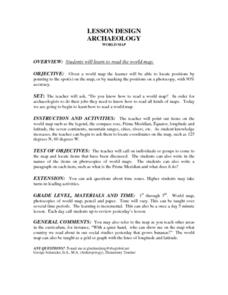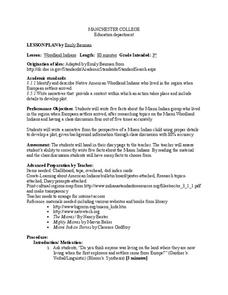Museum of the Moving Image
Political Ads in Historical Context
Campaign ads target both timely issues and general themes. Presidential campaign ads from 1952 and 1988 provide class members an opportunity to compare how the topics ads choose to address can dramatically influence election outcomes.
Curated Video
Copyright
Introduce your class to the concept of copyright with a series of activities. Pupils first learn about copyright laws and fair use, putting their knowledge to the test with a quick categorizing task. They then watch a video and answer...
Curated Video
Online Reputation and Cyber-bullying
Combat cyberbullying with information. During this plan, learners watch a couple of videos, consider online behavior scenarios, brainstorm long- and short-term consequences, and discuss how to react to bullying in order to build up to...
University of the Desert
Leaders in the Wilderness
What would the world be like if each person acted with greater cultural awareness and understanding? Learners consider the impact of cultural diffusion, as well as how global leaders can address some of today's pressing...
Curated OER
A Leopard Doesn’t Change Its Spots
First, introduce rank badges, which were used during the Qing Dynasty. Then, the class will work together to uncover the meaning of the images they see. They'll examine and research the meaning behind the symbols found on Leopard Rank...
Teaching Tolerance
Reflection: What’s Your FRAME?
Encourage your class to recognize the diversity in the beliefs and backgrounds of their peers. Learners use the acronym FRAME to consider culture, background, and life experiences.
Curated OER
What do Maps Show?
Eighth graders practice the skill of reading maps. In this geography lesson, 8th graders participate in a classroom lecture on how to read a map.
Curated OER
Roman Empire: Physical Framework - Location, Borders, Dimensions
Students relate the classical world to the modern world. In this map skills lesson, students turn a blank map into a colorful complete map by following step-by-step directions. This lesson allows students to connect our current geography...
Curated OER
The Gold Rush
Students identify the routes involved in the Gold Rush on a map. In this map skills lesson, students use a United States map to locate the routes used to travel to California during the Gold Rush. Students demonstrate how to use the map...
Curated OER
Lesson Design Archaeology- World Map
Students practice locating positions on the world map. In this map skills lesson, students explore the world map and items such as the compass rose, Equator, mountains, cities, etc. The students practice locating positions on the world...
Curated OER
First Amendment Rights
Fifth graders participate in a problem-solving and decision-making process involving the First Amendment rights to analyze and implement a solution for a school-related issue. They are given a variety of scenarios to apply the First...
Curated OER
The Effects of Limited Space on a Culture
Students predict the impact of population density on shelter, transportation, recreation, land use, and social skills and then research that impact on Japan. They write a response about the impact of population density on food...
Curated OER
At the Edge of the Continent
Students study how to interpret a bathymetric map. They study the main features of the continental margin. They plot and graph bathymetric data. They think about and discuss the bathymetry of the edge of the cont
Curated OER
Separation of Powers
Students examine the separation of powers in local and federal government. Using case studies, they review several instances of separation of powers. After reading the case studies, they write a brief opinion essays supporting their...
Curated OER
The Changing Landscape
Students examine the evolution of landscape painting in France from the 17th to the 19th century. They study and compare three landscape paintings, emphasizing space, depth, and the concepts of foreground, middle ground, and background.
Curated OER
Electricity--More Power to Ya!
Fourth graders use research tools to access and synthesize information. They gather and manipulate data using technology. Research and study the components of an electrical circuit. Create a brochure that demonstrates knowledge of how to...
Facing History and Ourselves
Analyzing Historical Evidence
High schoolers examine World War I war crimes. In this world history instructional activity, students use primary and secondary sources to research and understand the systematic nature of the Armenian Genocide. High schoolers reflect on...
Curated OER
Communicating With My World - Day Three: Internet
Students, who are studying ESL, examine the use of web sites. In this web site lesson plan, students watch a teacher demonstration of different types of web sites. They discuss how much time people spend on the Internet. They take a...
Curated OER
Guidelines for Teaching the Holocaust
Eighth graders view a presentation about the importance of the Holocaust. In groups, they complete a workshop in which they discover the reasons and actions behind the event. They share their feelings about the material and stereotypes...
Curated OER
Woodland Indians
Third graders research Woodland Indians. In this Woodland Indian lesson, 3rd graders have a classroom discussion and write facts about the Miami Indian group. They write a narrative from the perspective of an Indian child.
Curated OER
Changes in the Copper Penny
Third graders explore the difference between a physical change in a substance and a chemical change. students study the volume, density, altering shape and chemistry of a copper penny.
Curated OER
Roots And Styles Of Black Music - Lesson 1
High schoolers identify many genres of Black music. They identify Black music as a reflection of the culture. They study many historically influential Black music artists, producers, and other contributors.
Curated OER
Greek Gods Who Are They?
Sixth graders research a Greek God with a partner and prepare a presentation for the class. They use the computer and Internet, as a motivator for a Social Studies unit and explore the mythology, legends, values and beliefs of a people.
Curated OER
Understanding Treaties: Students Explore the Lives of Yakama People Before and After Treaties
Students analyze treaties made between the US government and Native American tribes. In this government activity, students evaluate bias emotionally connect with what was gained and lost during the late 1700's. This is a 3 part activity...























